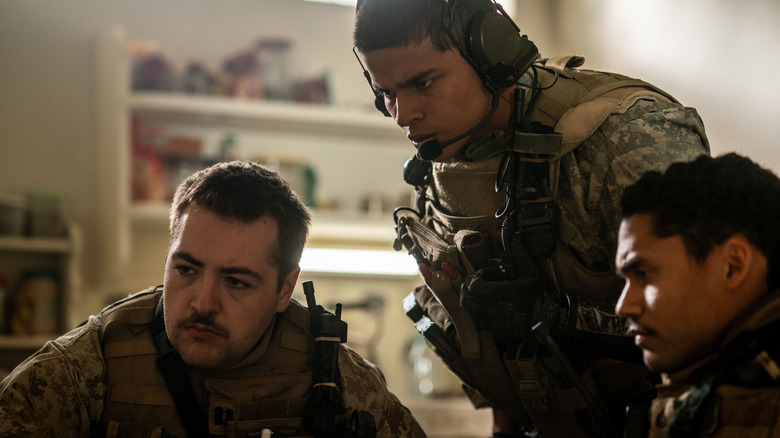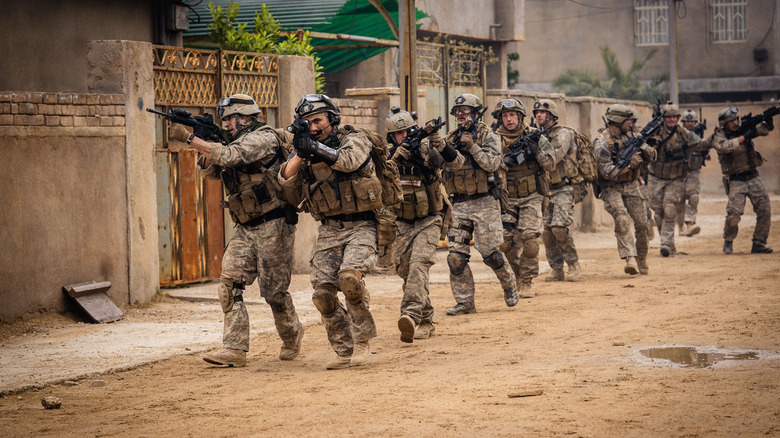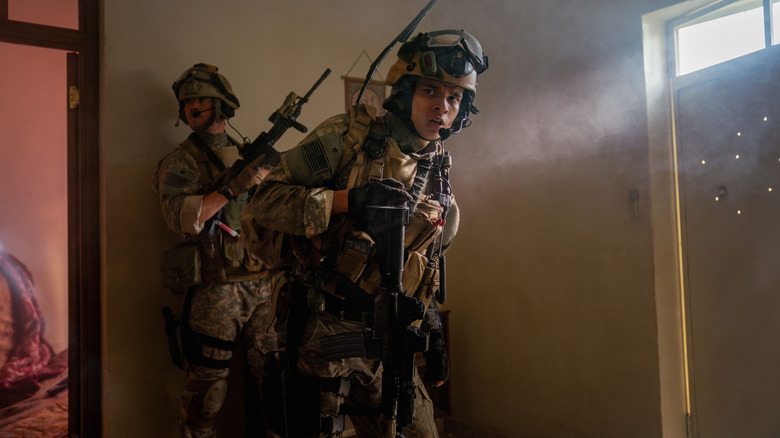There are your standard war films, and then there is “Warfare”, the existing worlds apart and in a league. The last effort of director of Alex Garland will inevitably feel recalling his action / anterior thriller of his heart a year ago, “civil war”, although with several key differences. On the one hand, viewers will quickly realize that there is no real “story” here in a traditional sense, rather stripped completely of speeches or acts of glory or exaggerated clichés. On the other hand, this film boots on the ground is much more limited, focusing on a single 2006 mission in Iraq, it has come down badly and said largely in real time. But more than anything else, “Warfare” is a refreshing story with little or no exaggeration, told specific points of view of those who were really there – including the codirector and veteran of the war in Iraq, Ray Mendoza.
Advertisement
And that the likelihood, in the end, is the key to what makes the “war” such an effective and painful watch. Although boasting of a cast filled with recognizable names and faces, the star of “Daredevil: Born Agour” Michael Gandolfini to the recent breakout artist, Charles Melton, in the new anonymous soldiers of Marvel, Joseph Quinn, “Warfare” is all about anonymous soldiers launched in the mud of war and their attempts to survive in the face of horrible and insane violence. But when the public begins to go to theaters to catch all the action on the big screen, many can move away from it by wondering how really it is based on real events.
True to the form, the creative team maintains that each frame of “war” is raw, not filtered and painfully real.
Advertisement
The origins of war, explained
For an experimental film as daring and ambitious as “Warfare”, its origins could surprise you. The creative partnership between Garland and Mendoza actually dates back to the manufacture of Garland’s “civil war” is also explosive ,,,, A fictitious representation of the United States in the near future collapses under the chaos of a military uprising against an overly ambitious president. It turns out that the role of Mendoza as a crucial military advisor has had a direct impact on the next project that the two would decide to continue.
Advertisement
In A recent interview with Jacob Hall De / FilmMendoza and Garland explained how the origins of production came from a tense sequence staged at the end of the “civil war”. Mendoza helped develop the logistics of the headquarters peak in the White House, in spill in real time and without cutting suddenly in the assembly to jump one of the minute. This led to a discussion on taking this same mentality and applying it to a whole film. According to Garland, “so in [post-production on ‘Civil War’] I called Ray and I said, “Are you interested in making a film that would last an hour and a half or an hour 40 [minutes]About almost, and would try to be completely faithful to a real sequence of events and we will not distort them or do not compress them or do not change them? […] And it turned out that there was a story that Ray wanted to tell for many years for all kinds of reasons, largely but personal reasons. “”
Advertisement
After having spoken to the other veterans involved and obtained permission to tell their story, Mendoza settled on a particular mission of Navy Seals during the Battle of Ramadi in 2006 in Iraq … but it was only the start of the process.
Rule number 1 in war was that “no one is authorized to invent something”
How far did the “war” fold the rules of conventional narration? Well, consider the fact that Garland and Mendoza stressed that the whole film was based only on memory. Taking their benchmarks of hours and hours of personal interviews, the directors spoke to many real soldiers involved in this series of events. Remember the details of an operation of almost 20 years in the past, where they have set up a shot as a sniper in a residential building in order to keep an eye on the insurgents in a neighboring area, already requires a lot. Transforming these memories and these memories into a feature film was something else.
Advertisement
But also tempting that it could have embellished certain facts or diverge real events in order to make things a little more dramatic, the filmmakers rather established basic rules on how to approach the production of this film. Garland apparently was directly inspired by The so-called dogma movement ’95 Pioneer by authors like Lars von Trier, who highlighted the idea of a naturalist cinema taken to the extreme. As Garland explained in his conversation with / film:
“So, it was a bit like a dogma film in one direction, except that the Dogme rule was that nobody is allowed to invent something and that everything that makes its way in the film must be, you can find it from a first-hand account. So, it is not limited, it ends my actor. People there say:” You did not work to the window, you sit right: “Well, it is the end of the conversation.
Advertisement
Consequently, in general, everything in “Warfare” is based on a true story – whether from misty memories, official military accounts of strategy and training, or simply an extension of what each soldier felt at some point. The result is a really unique rare experience of any other.
You can hear the full interview with the filmmakers of today’s episode of the Daily Podcast: Daily Film:
You can subscribe to / daily movie Apple podcasts,, Covered,, SpotifyOr wherever you get your podcasts, and send your comments, questions, comments, concerns and email bag subjects to bpearson@slashfilm.com. Please leave your name and general geographical location in case we mention your email in the waves.
“Warfare” is now playing in theaters.






